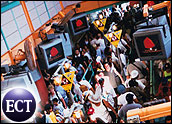
According to the American Bankers Association, the average consumer has two accounts with any one bank. One is typically a checking account, and with the plethora of free checking options available today, that one hardly counts. It’s not profitable.
Relationship banking is the carrot, not the stick, approach to growing profitability. Banks incent their most attractive customers to change their behavior — consolidate their financial accounts with one institution or engage in more profitable products like credit lines and loans — and capture more of their business. Fortunately, they’re thinking the better of penalizing customers for having single-product, unprofitable relationships with them.
Tracey Mills, senior manager of public relations for the Washington, D.C.-based American Bankers Association, defines consumers’ current penetrations of bank offerings as dating. It’s certainly not a relationship.
“Once someone goes over three relationships, that’s when banks have their loyalty locked in and start generating profits,” she says.
Marketing Makeover
To achieve this, a handful of banks have rolled out relationship banking rewards programs for all customers.
“Marketing has stepped up to the challenge to keep up with trends and provide great customer service,” Mills says.
“Response rates to financial services direct mail is at an all-time low and the ability to get new customers through direct mail is really horrendous,” adds Chris Moloney, vice president of loyalty and retention marketing at Parago, Lewisville, Texas. “Mass media advertising is cost-prohibitive. The alternative is to use existing relationships. They are the most efficient way to get out there.”
And with the cost to acquire new customers rising ever markedly against the cost to retain customers, “banks are really going after customers they want to hang onto for a long time,” says Moloney.
Rewarding All Segments
“Relationship banking is more known with high-end customers,” says Mills. For some financial firms, high-net-worth clients will continue to hold the spotlight in their relationship banking programs. UBS, for instance, recently announced a dual-card program that will give its wealthy customers access to a charge card, credit line and ATM services on a single account. The American Express charge card and Visa Signature credit card will pool rewards points rather than splitting them and delaying the opportunity to redeem.
Local banks, whether they’ve attended chiefly to affluent customers or spread warm fuzzies to all segments, have had greater success with relationship marketing efforts, Mills adds. They know their customers personally and can identify their needs based on experience, not a scientific model. “Customer service solidifies bank relationships. The more customers want, the more banks are providing,” she says.
Not only has this trend spread from wealthy consumer segments to middle-class patrons of local banks, but it increasingly embraces the unbanked.
Moloney says the growth of microbanks, such as Ace Cash Express, has prodded retail banks to develop products for the financially unstable. The offerings include prepaid debit cards, payroll cards and check-cashing services for customers who don’t have a primary bank account. Customers engaging with the bank on periphery products and services eventually are groomed for deposit accounts and developed as long-term relationship prospects.
“More and more people are trying to get into the space and influence that group,” Moloney says.
“In the U.S. we’re now reaching 80 percent home ownership. Credit is more available. It’s safe to assume that people’s financial relationships are going to grow,” Mills adds, supporting the strategy.
Whatever It Takes
“Larger institutions use technology to get to know customers and identify certain trends they may be a part of,” she says. The scale on which they work prevents them from taking the face-to-face approach that small banks use to offer the right products for cross sales.
And the technology comes none too soon, confirms Moloney. “Generation X and Generation Y are very open to profitable products like debit and credit cards, but they present a challenge for banks,” he says. Bank branches used to command profits and facilitate huge cross-sale volume. But a large percentage of people under 40 simply don’t go into branches. They use ATMs and the Web only.
“To get these people to try a mortgage or a loan, relationship banking is a great vehicle to incent them. They’re never going to go to visit a teller,” says Moloney. A rules engine behind a relationship banking database is the way to deepen these already profitable relationships. It can tease appropriate products to existing customers as they interact with ATMs or the Web and stem the attrition of a group more likely to switch banks than their parents’ generation.
“Boomers and older people are still going to branches, but for Generation X, their bank is every 7-Eleven where there is an ATM,” he says.






















































